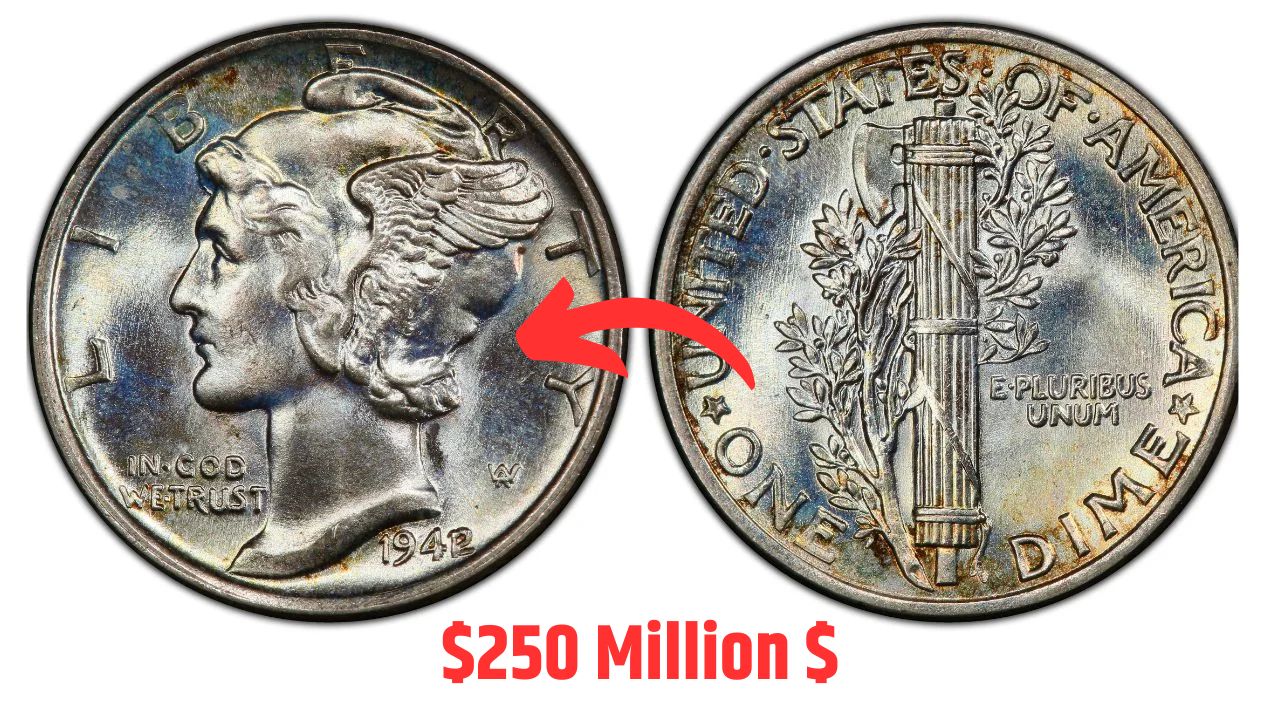In the world of numismatics, few coins command attention quite like the Mercury Dime. Struck between 1916 and 1945, this small silver coin has become a giant in the eyes of collectors—not just for its beauty and historical significance, but for its staggering market value. As of 2025, nine specific Mercury Dimes have earned a legendary status, with estimated valuations of $250 million each.
While such valuations may seem surreal, they’re backed by extreme rarity, pristine condition, historical relevance, and insatiable collector demand. Let’s explore these numismatic marvels, understand what makes them so valuable, and learn how to identify one if you’re lucky enough to find it.
The Mercury Dime: A Legacy in Silver
A Misunderstood Icon
Despite the name, the Mercury Dime does not feature the Roman god Mercury. Designed by Adolph A. Weinman, the coin shows Liberty wearing a winged cap, symbolizing freedom of thought. The nickname “Mercury Dime” stuck because of the coin’s resemblance to the god’s traditional appearance.
Technical Specs:
- Years Minted: 1916–1945
- Composition: 90% silver, 10% copper
- Weight: 2.5 grams
- Mints: Philadelphia (no mint mark), Denver (D), San Francisco (S)
The 9 Mercury Dimes Worth $250 Million Each
These nine coins represent the rarest, most desirable Mercury Dimes ever produced. Some are famous errors, others are incredibly rare in pristine condition, and a few are so scarce that only a handful are known to exist.
1. 1916-D Mercury Dime
- Key Traits: First year of issue, only 264,000 minted in Denver
- Why It’s Valuable: Most were circulated before collectors noticed, making high-grade examples extremely rare.
2. 1942/1 Overdate (Philadelphia)
- Error Type: 1942 struck over 1941 die
- Notable Features: Overlapping dates visible under magnification
- Value Factor: One of the most dramatic and famous overdate errors in U.S. coinage.
3. 1942/1-D Overdate (Denver)
- Rarer than the Philly version
- Distinctive “D” mint mark
- Collectors’ Dream: A genuine rarity with very few top-grade examples.
4. 1921-D Mercury Dime
- Low mintage due to post-WWI recession
- Hard to Find in Mint State
- Why It’s Rare: Low production plus limited preservation.
5. 1945 Micro S Mercury Dime
- Tiny “S” mint mark from San Francisco
- Final year of the Mercury Dime series
- Hidden Gems: Many remain unrecognized in collections.
6. 1919-D Mercury Dime
- Common in lower grades but rare in MS65+ with full bands
- Scarcity: Full split bands (FSB) are nearly impossible to find.
7. 1916 (Philadelphia) with Full Bands
- No mint mark
- First-year issue
- Collector Value: In Mint State with full bands, it’s a standout rarity.
8. 1944 Mercury Dime Struck on War Nickel Planchet
- Mint Error: Struck on a 35% silver nickel planchet
- Lightweight & off-color
- Why It’s Rare: A freak accident with only a few confirmed examples.
9. 1920-D Mercury Dime
- Denver mint mark
- Rare in high grade, especially with full bands
- Market Potential: Known to fetch five- to six-figure prices in pristine condition.
Why Are These Mercury Dimes Worth So Much?
| Factor | Impact on Value |
|---|---|
| Rarity | Low mintage and limited surviving examples |
| Condition (Grade) | Only a few exist in Mint State or with full split bands |
| Errors and Variations | Overdates and off-metal strikes are highly sought-after |
| Historical Context | Minted during wars, depressions, and significant U.S. eras |
| Collector Demand | Ultra-wealthy collectors drive prices into the stratosphere |
While the $250 million valuation is speculative and likely inflated by rarity hype, private collectors and institutions routinely pay six and even seven figures for these coins when they surface.
Tips for Identifying Valuable Mercury Dimes
Here’s how to spot a gem in your own collection:
Look for These Traits:
- Dates: Focus on 1916-D, 1921-D, 1942/1, 1945 Micro S, 1920-D, etc.
- Mint Marks: “D” (Denver) and “S” (San Francisco) under the date
- Full Bands (FSB): The horizontal lines on the reverse torch should be fully split and defined
- Weight: Off-metal errors weigh differently (a standard dime = 2.5 grams)
- Color & Shine: Original luster, no heavy wear, minimal marks
Watch Out For:
- Counterfeit mint marks
- Cleaned or altered coins (these reduce value)
- Coins that look shiny but have been polished
Mercury Dime Market Trends in 2025
| Trend | Impact |
|---|---|
| Shrinking Supply | Coins disappearing into private collections |
| Wealth Concentration | Billionaires entering collectibles market |
| Technology in Grading | New tools expose errors and boost collector awareness |
| Global Collector Interest | International buyers adding pressure to U.S. market |
The Mercury Dime is no longer just a nostalgic coin—it’s now seen as an alternative asset, much like fine art or rare watches.
FAQs
Are Mercury Dimes still in circulation?
Extremely rare. Most were pulled decades ago for their silver value, but the occasional dime does surface in estate sales or coin rolls.
What is the most valuable Mercury Dime ever sold?
A 1916-D in MS67 Full Bands has sold for over $200,000. No $250M sale has been confirmed publicly.
What does “Full Bands” mean?
It refers to the fully defined horizontal lines on the torch on the reverse. It’s a sign of a strong strike and high quality.
Are there fake Mercury Dimes?
Yes. Altered dates and counterfeit mint marks exist. Always verify with a reputable dealer or grading service (PCGS, NGC).
What years should I check first?
Start with 1916-D, 1921-D, 1920-D, 1942/1, and 1945 Micro S. These are among the most desirable.





















